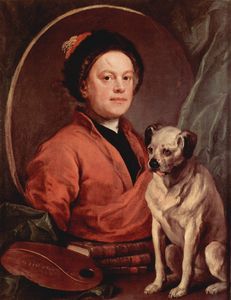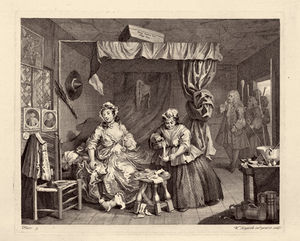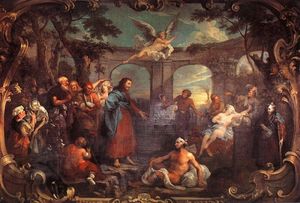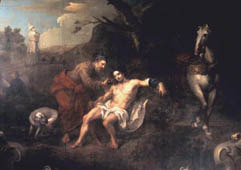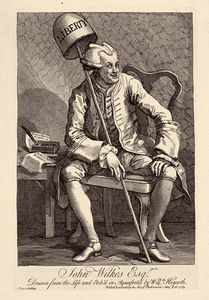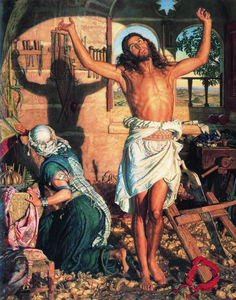William Hogarth Critical Reception
- Full Name:
- William Hogarth
- Short Name:
- Hogarth
- Date of Birth:
- 10 Nov 1697
- Date of Death:
- 26 Oct 1764
- Focus:
- Paintings
- Mediums:
- Oil, Prints, Wood, Other
- Subjects:
- Figure, Scenery
- Art Movement:
- Rococo
- Hometown:
- London, United Kingdom
- William Hogarth Critical Reception Page's Content
- During Life
- After Death
William Hogarth During Life
William Hogarth was successful during his lifetime and the key to this success seems to have been finding a new art genre that was perfect for the time in which he lived. Hogarth's use of humor and satire made his work immediately relatable to people from all walks of life.
Moral Paintings:
Hogarth's moral series, such as A Harlot's Progress and A Rake's Progress were so popular that they had to be reprinted and were made into plays and pantomimes. Hogarth's friends within the art world, men such as Fielding, believed that there was no one better to represent the real London of the day but Hogarth.
In his journal 'The Champion' in 1740 Fielding wrote: "In his (Hogarth's) excellent works, you see the delusive scene exposed with all the force of humor, and on casting your eyes on another picture you behold the dreadful and fatal consequence".
Biblical Work:
Hogarth did, on occasion, produce historical or biblical works, such as The Pool of Bethesda and The Good Samaritan. Unfortunately they never received any critical acclaim and he never received any commissions for similar pieces.
The artist Joshua Reynolds is known to have dismissed Hogarth's historical works at the time they were produced: "(Hogarth) Very imprudently or rather presumptuously, attempted the great historical style, for which his previous habits had by no means prepared him"
Reynolds does go on to say that: "Hogarth's genius, been employed on low and confined subjects, the praise which we give must be limited in its object".
Hogarth himself was always very dismissive of criticism from his contemporaries and art critics of the day. In typically outspoken style he is noted to have said: "All the world is competent to judge my pictures except those who are of my profession".
John Wilkes:
The very nature of satire means that a famous figure is often the butt of a joke. One example of this is the critic, journalist and MP John Wilkes. In his paper The Northern Briton he wrote a scathing appraisal of Hogarth's recent anti-war work The Times, describing it work as, "confused, perplexed and embarrassed."
In response to this criticism Hogarth produced an equally damning caricature of Wilkes. The engraving depicts the MP wearing a symbolic cap of liberty in such a way that it appears to be a halo along with a wig shaped like horns.
The Analysis of Beauty:
When Hogarth published The Analysis of Beauty in 1753 many critics found it laughable that an artist such as him, who created work that was realistic and gritty, could consider himself an expert in defining beauty.
William Hogarth After Death
Pre-Raphaelite:
If imitation is the sincerest form of flattery then painters such as Hunt and Brown were surly Hogarth's most positive critics. You can see similarities between Hogarth's work and the Pre-Raphaelites when you examine a painting such as Hunt's The Shadow of Death. The techniques listed below are employed by Hunt to evoke a certain moral message and such techniques were first used by William Hogarth.
Middle-class anti-aristocratic emphasis upon work as ennobling
Original painted image disseminated as engraving
Strong narrative emphasis
Satirical attacks on aristocracy
Today many art historians recognize Hogarth as the father of a genre and one of the first great English artists of his generation. Even the biblical paintings which were not popular in Hogarth's time are appreciated today for their skill.
Brian Sewell:
The art critic Brain Sewell has recently changed his perception of Hogarth as an artist: "Thirty-six years ago I accepted without question the received view of Hogarth as "a painter's painter" and "the father of English painting."
"With appropriate virtue but not enough decorum, Hogarth wrestled English painting out of the dead end of portraiture and into Manners and Morals."
The Tate:
Tate Britain in London houses a great deal of Hogarth's work and curators of an exhibition of Hogarth's work in 2007 noted that it is easy to overlook his work as it has been used in books, plays, radio, television and advertising for so many years.
They do however note that it is important to look at the variety of his work. The different genres and styles which were produced show innovation which was not matched during Hogarth's lifetime.
Hogarth can be used as one of the main points of reference for 18th century life in London and many of his contemporaries, like Fielding and Swift, believed that there was no better way of demonstrating the sights, sounds and smells of the city than through Hogarth's work.

